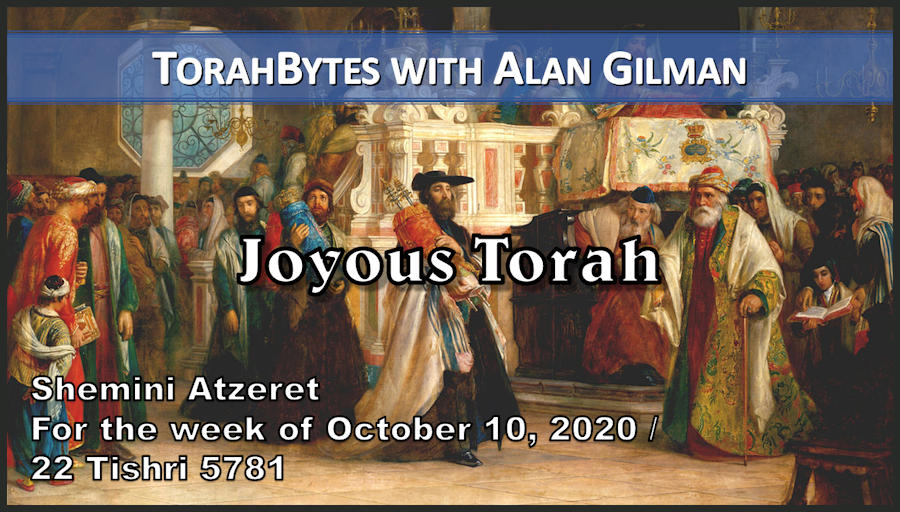For the week of October 10, 2020 / 22 Tishri 5781

Painting: The Feast of the Rejoicing of the Law at the Synagogue in Leghorn, Italy by Solomon Hart, 1850. Public Domain.
Shemini Atzeret
Torah: D’varim/Deuteronomy 14:22 – 16:17; B’midbar/Numbers 29:35 – 30:1
Haftarah: 1 Melachim / 1 Kings 8:54-66
Download Audio [Right click link to download]
So Moses told the people of Israel everything just as the LORD had commanded Moses. (B’midbar/Numbers 29:40)
This weekend brings the annual high holy day season to a close. Beginning with Rosh Hashanah, the new year, the traditional expression of the biblical Feast of the Blowing of the Shofar (ram’s horn); followed ten days later by Yom Kippur (the Day of Atonement), a national day of humility; it culminates with Sukkot (the Feast of Booths), a week-long harvest thanksgiving festival that commemorates God’s care and provision of the Israelites during the forty years in the wilderness prior to entering the Promised Land.
Sukkot lasts seven days plus one. Each year, after the people of Israel live in temporary dwellings for seven days, we were to move back into our permanent dwellings and observe an additional holy day. Thus, it became known as Shemini Atzeret, the eighth day of assembly, which this year begins Friday evening, October 9; coinciding with Shabbat.
A feature of Shemini Atzeret is that it marks the restarting of the annual Torah reading cycle. This celebration, called Simchat Torah (English: Rejoicing Over the Torah) is one of the most joyous Jewish occasions of the year. The Torah Scrolls are removed from their special cabinet and carried inside and outside the synagogue with exuberant singing and dancing. In Israel, Simchat Torah is observed the same day as Shemini Atzeret. While in the diaspora, it is the following day (this year, beginning the evening of October 10).
Non-Jews familiar with the Bible may find it curious to associate rejoicing with what is commonly known as “the Law.” Doesn’t the New Testament teach that the Law was the heavy yoke that crushed the ancient Israelites (see Matthew 11:28-30 and Acts 15:10), and that its only purpose was to demonstrate the sinfulness of human nature (see Romans 3:19-20)? But if that is the case, why then would King David write: “the precepts of the Lord are right, rejoicing the heart” (Psalm 19:8)?
The negative caricature of the Torah, supposedly derived from the New Covenant Writings, is one of the greatest tragedies of history. The true purpose of Torah has been obscured by confusing it with the system of the Sinai Covenant along with additional overbearing obligations forced upon people by religious leaders over time. Moreover, Torah’s illumination of human nature is a good thing designed by God to lead people to depend on him for the godliness delineated in Torah, not to disparage it nor discard it.
All of God’s written Word, beginning with the Torah as its foundation, is life giving. Through its pages we are instructed in his perfect ways. From sexuality to hygiene to politics to agriculture to business, God’s Torah, his instruction, guide our lives in a path of goodness, health, and life.
Torah was given to Israel at Mount Sinai and eventually shared with the world through the followers of the Jewish Messiah. The ways of God as revealed in Scripture are not principles developed by reason or higher consciousness; they are a gift from heaven. A gift certainly worth celebrating!
Scriptures taken from the English Standard Version unless otherwise indicated
Could you please be more specific about your reference to “the system of the Sinai covenant”? Thank you
Sherry,
Torah is often regarded as equivalent to the covenant given by God at Mt. Sinai. It is better understood as the revelation of God’s ways as communicated primarily through that covenant. This distinction is crucial, since there are elements of this covenant that are exclusive to it, such as the sacrifices. The promise of the New Covenant as promised through Jeremiah anticipates the internalization of Torah while clarifying that the covenant is different from the older one (see Jer. 31:31ff). The people of Israel were judged by God on the basis of the Sinai Covenant. Forgiveness for Israel and the inclusion of non-Jews as full participants in God’s family of faith required a new covenant system in which the universal principles of Torah as revealed through the whole Scripture could be effectively embraced and practiced.
Alan
Amen!